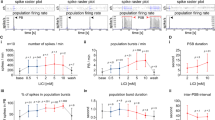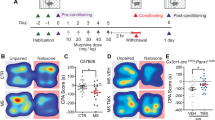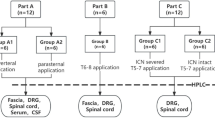Abstract
Aim:
The purpose of the present study was to explore how lidocaine as a therapeutic drug for tinnitus targets voltage-and ligand-gated ion channels and changes the excitability of central auditory neurons.
Methods:
Membrane currents mediated by major voltage-and ligand-gated channels were recorded from primary cultured neurons of the inferior colliculus (IC) in rats with whole-cell patch-clamp techniques in the presence and absence of lidocaine. The effects of lidocaine on the current-evoked firing of action potentials were also examined.
Results:
Lidocaine at 100 μmol/L significantly suppressed voltage-gated sodium currents, transient outward potassium currents, and the glycine-induced chloride currents to 87.66 ± 2.12%, 96.33 ± 0.35%, and 91.46 ± 2.69% of that of the control level, respectively. At 1 mmol/L, lidocaine further suppressed the 3 currents to 70.26 ± 4.69%, 62.80 ± 2.61%, and 89.11 ± 3.17% of that of the control level, respectively. However, lidocaine at concentrations lower than 1 mmol/L did not significantly affect GABA-or aspartate-induced currents. At a higher concentration (3 mmol/L), lidocaine slightly depressed the GABA-induced current to 87.70 ± 1.87% of that of the control level. Finally, lidocaine at 100 μmol/L was shown to significantly suppress the current-evoked firing of IC neurons to 58.62 ± 11.22% of that of the control level, indicating that lidocaine decreases neuronal excitability.
Conclusion:
Although the action of lidocaine on the ion channels and receptors is complex and non-specific, it has an overall inhibitory effect on IC neurons at a clinically-relevant concentration, suggesting a central mechanism for lidocaine to suppress tinnitus.
Similar content being viewed by others
Log in or create a free account to read this content
Gain free access to this article, as well as selected content from this journal and more on nature.com
or
References
Henry JA, Dennis KC, Schechter MA . General review of tinnitus: prevalence, mechanisms, effects, and management. J Speech Lang Hear Res 2005; 48: 1204–35.
Lockwood AH, Salvi RJ, Burkard RF . Tinnitus. N Engl J Med 2002; 347: 904–10.
Baguley DM, Jones S, Wilkins I, Axon PR, Moffat DA . The inhibitory effect of intravenous lidocaine infusion on tinnitus after translabyrinthine removal of vestibular schwannoma: a double-blind, placebo-controlled, crossover study. Otol Neurotol 2005; 26: 169–76.
Barany R . Die Beeinflussung des Ohrensausens durch intravenos injezierte Lokalanasthetika. Acta Otolaryngol 1935; 23: 201–3.
Schmidt H, Davis A, Stasche N, Hormann K . The lidocaine test in tinnitus. Determination of its current status. HNO 1994; 42: 677–84. In German.
Majumdar B, Mason SM, Gibbin KP . An electrocochleographic study of the effects of lignocaine on patients with tinnitus. Clin Otolaryngol Allied Sci 1983; 8: 175–80.
Eggermont JJ . Central tinnitus. Auris Nasus Larynx 2003; 30 ( Suppl): S7–12.
Mirz F, Pedersen B, Ishizu K, Johannsen P, Ovesen T, Stodkilde-Jorgensen H, et al. Positron emission tomography of cortical centers of tinnitus. Hear Res 1999; 134: 133–44.
Simpson JJ, Davies WE . Recent advances in the pharmacological treatment of tinnitus. Trends Pharmacol Sci 1999; 20: 12–8.
Kaltenbach JA . The dorsal cochlear nucleus as a participant in the auditory, attentional and emotional components of tinnitus. Hear Res 2006; 216–7: 224–34.
Moller AR . Neural plasticity in tinnitus. Prog Brain Res 2006; 157: 365–72.
Wang HT, Luo B, Zhou KQ, Xu TL, Chen L . Sodium salicylate reduces inhibitory postsynaptic currents in neurons of rat auditory cortex. Hear Res 2006; 215: 77–83.
House JW, Brackmann DE . Tinnitus: surgical treatment. Ciba Found Symp 1981; 85: 204–16.
Reyes SA, Salvi RJ, Burkard RF, Coad ML, Wack DS, Galantowicz PJ, et al. Brain imaging of the effects of lidocaine on tinnitus. Hear Res 2002; 171: 43–50.
Kalcioglu MT, Bayindir T, Erdem T, Ozturan O . Objective evaluation of the effects of intravenous lidocaine on tinnitus. Hear Res 2005; 199: 81–8.
Vermeij P, Hulshof JH . Dose finding of tocainide in the treatment of tinnitus. Int J Clin Pharmacol Ther Toxicol 1986; 24: 207–12.
Trellakis S, Benzenberg D, Urban BW, Friederich P . Differential lidocaine sensitivity of human voltage-gated potassium channels relevant to the auditory system. Otol Neurotol 2006; 27: 117–23.
Ruth RA, Gal TJ, DiFazio CA, Moscicki JC . Brain-stem auditory-evoked potentials during lidocaine infusion in humans. Arch Otolaryngol 1985; 111: 799–802.
Manabe Y, Yoshida S, Saito H, Oka H . Effects of lidocaine on sali-cylate-induced discharge of neurons in the inferior colliculus of the guinea pig. Hear Res 1997; 103: 192–8.
Basta D, Ernst A . Effects of salicylate on spontaneous activity in inferior colliculus brain slices. Neurosci Res 2004; 50: 237–43.
Bauer CA, Brozoski TJ, Holder TM, Caspary DM . Effects of chronic salicylate on GABAergic activity in rat inferior colliculus. Hear Res 2000; 147: 175–82.
Tang ZQ, Lu YG, Zhou KQ, Xu TL, Chen L . Amiloride attenuates glycine-induced currents in cultured neurons of rat inferior colliculus. Biochem Biophys Res Commun 2006; 350: 900–4.
Murase K, Ryu PD, Randic M . Excitatory and inhibitory amino acids and peptide-induced responses in acutely isolated rat spinal dorsal horn neurons. Neurosci Lett 1989; 103: 56–63.
Arias HR . Role of local anesthetics on both cholinergic and serotonergic ionotropic receptors. Neurosci Biobehav Rev 1999; 23: 817–43.
Hirota K, Okawa H, Appadu BL, Grandy DK, Lambert DG . Interaction of local anaesthetics with recombinant mu, kappa, and delta-opioid receptors expressed in Chinese hamster ovary cells. Br J Anaesth 2000; 85: 740–6.
Yunoki M, Nakahara T, Mitani A, Maruko T, Kubota Y, Sakamoto K, et al. Lidocaine attenuates muscarinic receptor-mediated inhibition of adenylyl cyclase in airway smooth muscle. Eur J Pharmacol 2003; 470: 65–71.
Tanaka K, Yamasaki M . Blocking of cortical inhibitory synapses by intravenous lidocaine. Nature 1966; 209: 207–8.
Hodgkin AL, Huxley AF . Currents carried by sodium and potassium ions through the membrane of the giant axon of Loligo. J Physiol 1952; 116: 449–72.
Armstrong CM . Sodium channels and gating currents. Physiol Rev 1981; 61: 644–83.
Chevrier P, Vijayaragavan K, Chahine M . Differential modulation of Nav1.7 and Nav1.8 peripheral nerve sodium channels by the local anesthetic lidocaine. Br J Pharmacol 2004; 142: 576–84.
Matsubara T, Clarkson C, Hondeghem L . Lidocaine blocks open and inactivated cardiac sodium channels. Naunyn Schmiedebergs Arch Pharmacol 1987; 336: 224–31.
Xiao YF, Ke Q, Wang SY, Yang Y, Chen Y, Wang GK, et al. Electrophysiologic properties of lidocaine, cocaine, and n-3 fatty-acids block of cardiac Na+ channels. Eur J Pharmacol 2004; 485: 31–41.
Ptacek LJ, George AL Jr, Barchi RL, Griggs RC, Riggs JE, Robertson M, et al. Mutations in an S4 segment of the adult skeletal muscle sodium channel cause paramyotonia congenital. Neuron 1992; 8: 891–7.
Storm JF . Potassium currents in hippocampal pyramidal cells. Prog Brain Res 1990; 83: 161–87.
Grigg JJ, Brew HM, Tempel BL . Differential expression of voltage-gated potassium channel genes in auditory nuclei of the mouse brainstem. Hear Res 2000; 140: 77–90.
Sivaramakrishnan S, Oliver DL . Distinct K currents result in physiologically distinct cell types in the inferior colliculus of the rat. J Neurosci 2001; 21: 2861–77.
Wang Y, Strahlendorf JC, Strahlendorf HK . A transient voltage-dependent outward potassium current in mammalian cerebellar Purkinje cells. Brain Res 1991; 567: 153–8.
Eggermont JJ . Tinnitus: neurobiological substrates. Drug Discov Today 2005; 10: 1283–90.
Kurt M, Bilge SS, Kukula O, Kesim Y, Celik S . The role of nitrergic system in lidocaine-induced convulsion in the mouse. Jpn J Pharmacol 2001; 85: 92–4.
Author information
Authors and Affiliations
Corresponding author
Additional information
Project supported by grants from the National Natural Science Foundation of China (No 30470560 and 30730041), the National Basic Research Program of China (No 2007CB512306), and the CAS Knowledge Innovation Project (No KSCX1-YW-R-36).
Rights and permissions
About this article
Cite this article
Yu, M., Chen, L. Modulation of major voltage- and ligand-gated ion channels in cultured neurons of the rat inferior colliculus by lidocaine. Acta Pharmacol Sin 29, 1409–1418 (2008). https://doi.org/10.1111/j.1745-7254.2008.00893.x
Received:
Accepted:
Issue date:
DOI: https://doi.org/10.1111/j.1745-7254.2008.00893.x



